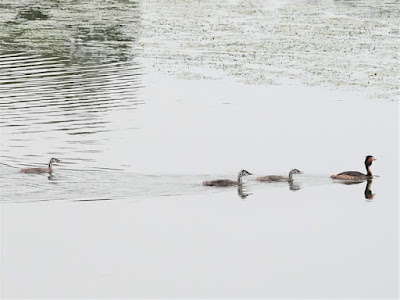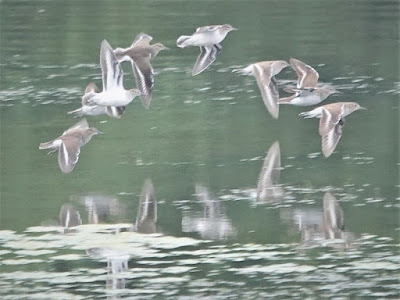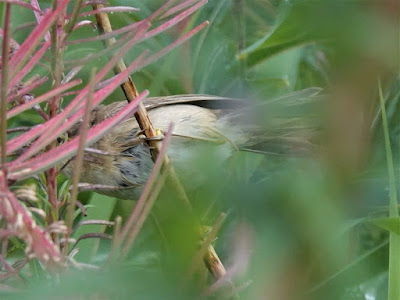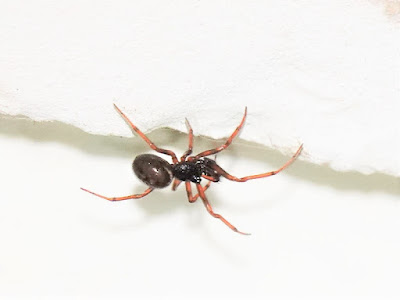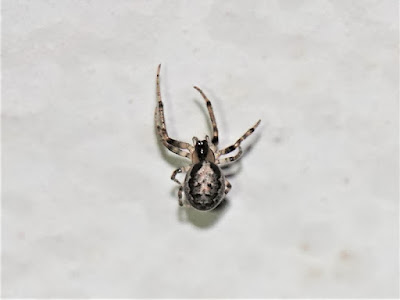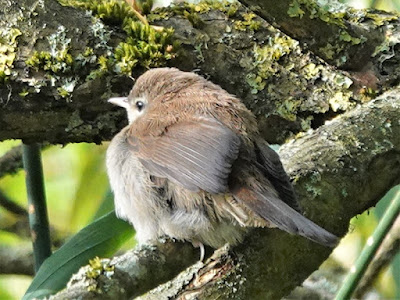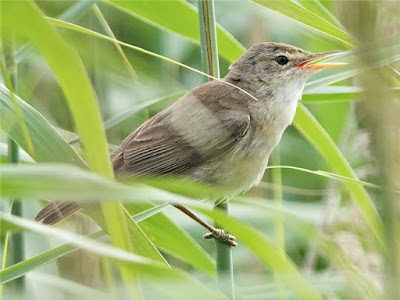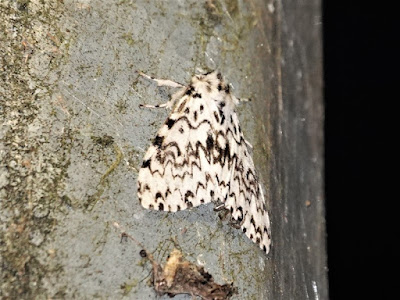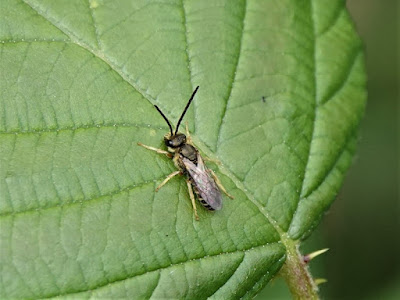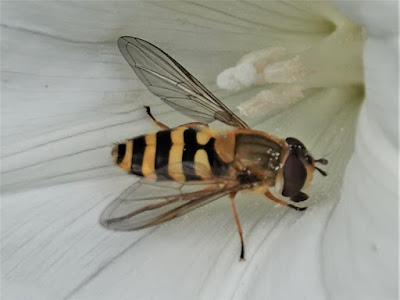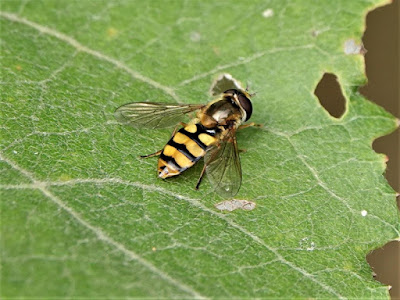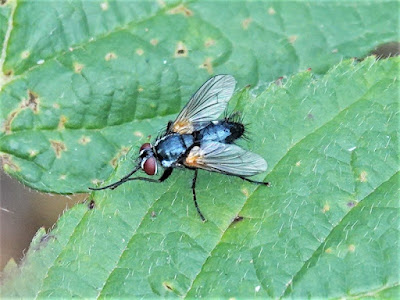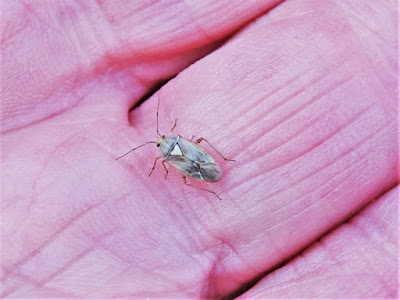No sightings in today
30 Jul 25
No sightings in today
2006
Priorslee Lake
13 Swifts
(Ed Wilson)
------------------------------------------------------------------------------------------------------
2006
Priorslee Lake
13 Swifts
(Ed Wilson)
29 Jul 25
Priorslee Balancing Lake and The Flash
12.0°C > 14.0°C: Overcast with spells of rain and / or drizzle. Almost calm. Mostly good visibility.
Sunrise: 05:25 BST
* = a species photographed today
$ = my first sighting of the species for this year
$$ = my first ever recorded sighting of the species in the area
Priorslee Balancing Lake: 05:15 – 06:25 // 07:30 – 09:35
(185th visit of the year)
A rain delayed start and a rain affected set of numbers.
Bird notes
Highlight today was seeing an eventual total of 11 Common Sandpipers together. I cannot recall such a large gathering of this species here on Autumn passage previously. In the past I have certainly noted double figures in Spring. Also I recall a party of, I think, 15, dropped in momentarily at The Flash where they are not common, especially in Autumn. At 05:30 while standing on the concrete slipway checking the birds on the south-west grass I could hear Common Sandpiper calls apparently high overhead. I could not see any but two birds suddenly appeared on one of the boat launching platforms. It was only later on my second lap that I flushed all eleven. I am pleased to say they all settled back down.
Other bird notes:
- just one Greylag Goose when I arrived. Again I am not sure any geese had over-nighted. Birds were later than usual arriving and I noted 48 Canada Geese and three Greylag Geese present. After I had departed from the immediate lake area I heard more geese arriving.
- no obvious Mallard ducklings were noted.
- the duck Pochard gone / hiding!.
- as yesterday four juvenile Great Crested Grebes noted. Two adults were displaying rather half-heartedly at the West end where there does not seem to have been a nest this year. If there was then no young were noted.
- as in several recently a second Grey Heron has arrived and landed on one of the buoys. It seems so long as it stays there the other bird is unconcerned.
- my slightly delayed arrival probably meant I was too late to see the main groups of Jackdaws flying over, outbound from their roosts.
- the weather dampened birds enthusiasm to sing. No song from the Blackbird was heard: neither were any of the Song Thrushes or warblers singing.
- a male Common Whitethroat was with other warblers at the West end.
Bird(s) noted flying over here:
- 31 Canada Geese: 23 outbound in three groups; eight inbound in three groups
- 28 Greylag Geese: 18 outbound in four groups; 10 inbound together
- 2 Mallard: singles
- 169 Wood Pigeons
- 1 Collared Dove
- 1 Lesser Black-baked Gull: fly-overs unusual
- 1 Herring Gull once more
- 2 Lesser Black-baked Gulls
- 35 Jackdaws
- 91 Rooks
Counts from the lake area:
- 48 Canada Geese: see notes
- 3 Greylag Geese: see notes
- 2 Mute Swans
- 22 (♂?) Mallard: see notes
- no Pochard
- 11 + 3 (2 dependent broods) Moorhens
- 112 Coots: another new brood (of two?) noted
- 7 + 4 (2 broods) Great Crested Grebes: see notes
- 11 Common Sandpipers
- 9 Black-headed Gulls: no juveniles
- 7 Lesser Black-baked Gulls
- 2 Grey Herons: one arrived
Hirundines etc. noted:
12.0°C > 14.0°C: Overcast with spells of rain and / or drizzle. Almost calm. Mostly good visibility.
Sunrise: 05:25 BST
* = a species photographed today
$ = my first sighting of the species for this year
$$ = my first ever recorded sighting of the species in the area
Priorslee Balancing Lake: 05:15 – 06:25 // 07:30 – 09:35
(185th visit of the year)
A rain delayed start and a rain affected set of numbers.
Bird notes
Highlight today was seeing an eventual total of 11 Common Sandpipers together. I cannot recall such a large gathering of this species here on Autumn passage previously. In the past I have certainly noted double figures in Spring. Also I recall a party of, I think, 15, dropped in momentarily at The Flash where they are not common, especially in Autumn. At 05:30 while standing on the concrete slipway checking the birds on the south-west grass I could hear Common Sandpiper calls apparently high overhead. I could not see any but two birds suddenly appeared on one of the boat launching platforms. It was only later on my second lap that I flushed all eleven. I am pleased to say they all settled back down.
Other bird notes:
- just one Greylag Goose when I arrived. Again I am not sure any geese had over-nighted. Birds were later than usual arriving and I noted 48 Canada Geese and three Greylag Geese present. After I had departed from the immediate lake area I heard more geese arriving.
- no obvious Mallard ducklings were noted.
- the duck Pochard gone / hiding!.
- as yesterday four juvenile Great Crested Grebes noted. Two adults were displaying rather half-heartedly at the West end where there does not seem to have been a nest this year. If there was then no young were noted.
- as in several recently a second Grey Heron has arrived and landed on one of the buoys. It seems so long as it stays there the other bird is unconcerned.
- my slightly delayed arrival probably meant I was too late to see the main groups of Jackdaws flying over, outbound from their roosts.
- the weather dampened birds enthusiasm to sing. No song from the Blackbird was heard: neither were any of the Song Thrushes or warblers singing.
- a male Common Whitethroat was with other warblers at the West end.
Bird(s) noted flying over here:
- 31 Canada Geese: 23 outbound in three groups; eight inbound in three groups
- 28 Greylag Geese: 18 outbound in four groups; 10 inbound together
- 2 Mallard: singles
- 169 Wood Pigeons
- 1 Collared Dove
- 1 Lesser Black-baked Gull: fly-overs unusual
- 1 Herring Gull once more
- 2 Lesser Black-baked Gulls
- 35 Jackdaws
- 91 Rooks
Counts from the lake area:
- 48 Canada Geese: see notes
- 3 Greylag Geese: see notes
- 2 Mute Swans
- 22 (♂?) Mallard: see notes
- no Pochard
- 11 + 3 (2 dependent broods) Moorhens
- 112 Coots: another new brood (of two?) noted
- 7 + 4 (2 broods) Great Crested Grebes: see notes
- 11 Common Sandpipers
- 9 Black-headed Gulls: no juveniles
- 7 Lesser Black-baked Gulls
- 2 Grey Herons: one arrived
Hirundines etc. noted:
None
As a postscript to my notes yesterday suggesting an early departure by the local Swifts I can add that only a very few birds remain around their Newport haunts.
Warblers recorded (the figure in brackets is birds noted singing):
- 1 (0) Cetti's Warbler
- 1 (0) Willow Warbler
- 12 (0) Chiffchaffs again
- 9 (0) Reed Warblers
- 4 (0) Blackcaps again
- 1 (0) Common Whitethroat
Noted on the West end street lamp poles around-dawn:
As a postscript to my notes yesterday suggesting an early departure by the local Swifts I can add that only a very few birds remain around their Newport haunts.
Warblers recorded (the figure in brackets is birds noted singing):
- 1 (0) Cetti's Warbler
- 1 (0) Willow Warbler
- 12 (0) Chiffchaffs again
- 9 (0) Reed Warblers
- 4 (0) Blackcaps again
- 1 (0) Common Whitethroat
Noted on the West end street lamp poles around-dawn:
Moths:
- none
- none
Spiders, harvestmen etc.:
- 3 Bridge Orb-web Spiders Larinioides sclopetarius
- 2 harvestmen Leiobunum blackwalli / rotundum
Noted later:
Very little noted in rain and wet vegetation
- 3 Bridge Orb-web Spiders Larinioides sclopetarius
- 2 harvestmen Leiobunum blackwalli / rotundum
Noted later:
Very little noted in rain and wet vegetation
Butterflies:
none
none
Moths
4 Straw Grass-moth Agriphila straminella [was Straw Grass-veneer]
4 Straw Grass-moth Agriphila straminella [was Straw Grass-veneer]
Bees, wasps etc.:
Common Wasp Paravespula vulgaris
Common Wasp Paravespula vulgaris
Hoverflies:
none
none
Dragon-/Damsel-flies:
none
none
Four-winged flies – Lacewings, Caddisflies etc.:
none
none
Other flies:
only unidentified fly species
only unidentified fly species
Bugs etc.:
none
none
Beetles:
7 Spot Ladybird Coccinella 7-punctata
7 Spot Ladybird Coccinella 7-punctata
Spiders, harvestmen etc.:
none
none
New plants for the year:
None
And here seven with the one in the middle (Paul Jones? 1960s pop reference. My era) giving a top-side plan view.
It was another day for photographing warblers. They were probably motivated out of the deepest cover by the wet vegetation. The strength of the eyebrow (supercilium) identifies this as a Willow Warbler.
A Blackcap. With a brown cap this could be a female or a juvenile of either sex though juvenile males usually grow a few black feathers before they fly off to sub-Saharan Africa for our Winter.
This species has a much thicker bill than many warblers and is more omnivorous. It especially likes Blackberries in the Autumn. It will have to be quick this year. I ate my first wild blackberry on 01 July, a full two weeks ahead of normal.
...a juvenile. Note the gape line and the pale tips and fringes to its new adult feathers. These will abrade during the rest of the year.
(Ed Wilson)
In the Priorslee Avenue tunnel:
A dreaded Box-tree Moth Cydalima perspectalis: my first in Shropshire. First recorded in the UK in 2007 and the West Midlands in 2017 this is an invasive species that originates from East Asia. It was likely accidentally imported as larvae in with Box Buxus plants as part of the horticultural trade. The larvae often destroy all the leaves of Box plants in many parts of the UK. It may be the only reason to welcome the Yellow-legged Asian Hornet Vespa velutina to out shores as it is thought this predator controls the natural Asian population of the moth. [Not really: the hornet could wipe out our native bees]. Despite the moth's very different appearance it is closely related to our grass moths.
This is possibly a Rabbit Hutch Spider Steatoda bipunctata according to Obsidentify. It does have the white crescent at the front of the abdomen shown by spiders in this genus. None of the photos on the web show such red legs though.
(181st visit of the year)
Bird notes:
- no Mallard ducklings seen again
- *four adult Great Crested Grebes again. I managed to see one juvenile on the back of one bird from the pair at the top end. I also confirmed that the pair by the island still have three juveniles.
Bird(s) noted flying over here:
- 1 Jackdaw
Noted on / around the water:
- 13 Canada Geese
- 3 Greylag Geese
- 6 Mute Swans
- 23 (?♂) Mallard
- 13 (?♂) Tufted Duck
- 7 Moorhens
- 84 + 5 (4 dependent broods) Coots:
- *4 + 4 (2 broods) Great Crested Grebes: see notes
- 5 Black-headed Gulls: no juveniles
Hirundines etc. noted:
An adult Great Crested Grebe with three juvenile humbugs.
All eleven Common Sandpipers in flight – there is a laggard at the extreme right.
Eight (nine I suspect) reflecting in the lake.
All eleven at rest.
I still think it is a clever trick of the Grey Heron to balance on a buoy like this. It always seems to do so with its neck stretched out – to help its balance? So long as it stays on the buoy the other Grey Heron leaves it alone. Note two Common Sandpipers flying by.
It was another day for photographing warblers. They were probably motivated out of the deepest cover by the wet vegetation. The strength of the eyebrow (supercilium) identifies this as a Willow Warbler.
And again. Note the dark bill.
A Chiffchaff showing its thinner and paler bill.
Not such a good view as yesterday of a Reed Warbler!
"I'm coming to get you!" Not enough light to freeze the action.
A splendid Common Whitethroat in the rain.
Again. Looking round-shouldered here.
It was not just warblers I noted sitting around in the rain. Here is a Song Thrush...
Also a moulting Robin.
(Ed Wilson)
------------------------------------------------------------------------------------------------------
In the Priorslee Avenue tunnel:
Moths: [36 species here before today; one (unwelcome) addition [one ID still pending]]
1 Box-tree Moth Cydalima perspectalis: my first in Shropshire
I had hoped for more sheltering from the rain...
1 Box-tree Moth Cydalima perspectalis: my first in Shropshire
I had hoped for more sheltering from the rain...
Flies:
6 moth flies Psychodidae sp. [Drain Fly or Owl Fly]
11 midges of various species.
6 moth flies Psychodidae sp. [Drain Fly or Owl Fly]
11 midges of various species.
Arthropods:
4 White-legged Snake Millipedes Tachypodoiulus niger
4 White-legged Snake Millipedes Tachypodoiulus niger
Spiders, harvestmen etc.:
1 possible Rabbit Hutch Spider Steatoda bipunctata
2 Missing Sector Orb-web Spiders Zygiella x-notata [Silver-sided Sector Spider]
other spiders not identified
1 harvestman Opilio canestrinii
1 possible Rabbit Hutch Spider Steatoda bipunctata
2 Missing Sector Orb-web Spiders Zygiella x-notata [Silver-sided Sector Spider]
other spiders not identified
1 harvestman Opilio canestrinii
A dreaded Box-tree Moth Cydalima perspectalis: my first in Shropshire. First recorded in the UK in 2007 and the West Midlands in 2017 this is an invasive species that originates from East Asia. It was likely accidentally imported as larvae in with Box Buxus plants as part of the horticultural trade. The larvae often destroy all the leaves of Box plants in many parts of the UK. It may be the only reason to welcome the Yellow-legged Asian Hornet Vespa velutina to out shores as it is thought this predator controls the natural Asian population of the moth. [Not really: the hornet could wipe out our native bees]. Despite the moth's very different appearance it is closely related to our grass moths.
A Missing Sector Orb-web Spider Zygiella x-notata with a glint in two of its eight eyes – the camera flash. Do I really need to use "red eye" setting on insects?
(Ed Wilson)
The Flash: 06:30 – 07:25
(Ed Wilson)
------------------------------------------------------------------------------------------------------
The Flash: 06:30 – 07:25
(181st visit of the year)
Bird notes:
- no Mallard ducklings seen again
- *four adult Great Crested Grebes again. I managed to see one juvenile on the back of one bird from the pair at the top end. I also confirmed that the pair by the island still have three juveniles.
Bird(s) noted flying over here:
- 1 Jackdaw
Noted on / around the water:
- 13 Canada Geese
- 3 Greylag Geese
- 6 Mute Swans
- 23 (?♂) Mallard
- 13 (?♂) Tufted Duck
- 7 Moorhens
- 84 + 5 (4 dependent broods) Coots:
- *4 + 4 (2 broods) Great Crested Grebes: see notes
- 5 Black-headed Gulls: no juveniles
Hirundines etc. noted:
None
Warblers recorded (the figure in brackets is birds noted singing):
- 6 (1) Chiffchaffs
- no Blackcaps
Noted around the area:
Nothing seen apart from:
Warblers recorded (the figure in brackets is birds noted singing):
- 6 (1) Chiffchaffs
- no Blackcaps
Noted around the area:
Nothing seen apart from:
Hoverflies:
*1 unidentified hoverfly asleep on a street lamp pole
*1 unidentified hoverfly asleep on a street lamp pole
Spiders, harvestmen etc.:
10 harvestmen Dicranopalpus ramosus/caudatus
1 harvestman Opilio canestrinii
An adult Great Crested Grebe from the top end with one juvenile humbug visible on its back. The adult seems to have a growth on the side of its face.
The other Great Crested Grebe family with one juvenile falling / climbing off the parent's back and two other humbugs in the water.
I am beaten to identify this hoverfly, asleep on one of the street lamp poles. It cannot be a Syrphus species as the scutellum (the half-moon area behind the thorax) is not yellow. All the other suggestions from the apps point to species that are either more narrowly-built; have spots that are white(ish) rather than yellow; or with the orientation of the uppermost spot angled differently. Drat.
(Ed Wilson)
2006
Priorslee Lake
1 Common Tern
(Ed Wilson)
10 harvestmen Dicranopalpus ramosus/caudatus
1 harvestman Opilio canestrinii
Same adult. Good at concealing however many humbugs there are.
(Ed Wilson)
------------------------------------------------------------------------------------------------------
2006
Priorslee Lake
1 Common Tern
(Ed Wilson)
28 Jul 25
Priorslee Balancing Lake and The Flash
13.0°C > 18.0°C: Some sunny intervals for a while: more cloud later. Light north-westerly breeze. Very good visibility.
Sunrise: 05:23 BST
* = a species photographed today
$ = my first sighting of the species for this year
$$ = my first ever recorded sighting of the species in the area
Priorslee Balancing Lake: 05:00 – 06:25 // 07:40 – 10:05
(184th visit of the year)
Bird notes:
- just one Greylag Goose when I arrived. I am not sure any had over-nighted: with the sailing club likely to have been on the water yesterday they may well have moved off. They did fly in later with eventually 59 Canada Geese and five Greylag Geese present.
- no obvious Mallard ducklings were noted.
- the duck Pochard seen again.
- a Tufted Duck was seen flying off East at 06:00
- four juvenile Great Crested Grebes noted: the brood of three was complete today (where has the third one been hiding). Just one other.
- the lone Blackbird was singing lustily at 05:05 and not heard thereafter.
- at least four Cetti's Warblers were seen and heard along the North side. Somewhat puzzling that most of the song heard earlier in the year was along the South side.
- a Willow Warbler was singing alongside Teece Drive c.06:20: a bird moving through on the long haul to sub-Saharan Africa.
- again small groups of Reed Warblers were seen. Today both in and away from the reeds.
Bird(s) noted flying over here:
- 10 Canada Geese: nine outbound in four groups; a single inbound
- 32 Greylag Geese: 15 outbound in five groups; 17 inbound in two groups
- 2 Stock Doves: singles
- 164 Wood Pigeons
- 1 Herring Gull yet again
- 7 Lesser Black-baked Gulls
- 141 Jackdaws
- 53 Rooks
Counts from the lake area:
- 59 Canada Geese: see notes
- 5 Greylag Geese: see notes
- 2 Mute Swans
- 25 (♂?) Mallard: see notes
- 1 (0♂) Pochard
- 1 (♂?) Tufted Duck: departed
- 11 + 6 (3 dependent broods) Moorhens
- 117 Coots
- 6 + 4 (2 broods) Great Crested Grebes: see notes
- 13 Black-headed Gulls: no juveniles
- 3 Lesser Black-baked Gulls
- 2 Grey Herons: one arrived
Hirundines etc. noted:
13.0°C > 18.0°C: Some sunny intervals for a while: more cloud later. Light north-westerly breeze. Very good visibility.
Sunrise: 05:23 BST
* = a species photographed today
$ = my first sighting of the species for this year
$$ = my first ever recorded sighting of the species in the area
Priorslee Balancing Lake: 05:00 – 06:25 // 07:40 – 10:05
(184th visit of the year)
Bird notes:
- just one Greylag Goose when I arrived. I am not sure any had over-nighted: with the sailing club likely to have been on the water yesterday they may well have moved off. They did fly in later with eventually 59 Canada Geese and five Greylag Geese present.
- no obvious Mallard ducklings were noted.
- the duck Pochard seen again.
- a Tufted Duck was seen flying off East at 06:00
- four juvenile Great Crested Grebes noted: the brood of three was complete today (where has the third one been hiding). Just one other.
- the lone Blackbird was singing lustily at 05:05 and not heard thereafter.
- at least four Cetti's Warblers were seen and heard along the North side. Somewhat puzzling that most of the song heard earlier in the year was along the South side.
- a Willow Warbler was singing alongside Teece Drive c.06:20: a bird moving through on the long haul to sub-Saharan Africa.
- again small groups of Reed Warblers were seen. Today both in and away from the reeds.
Bird(s) noted flying over here:
- 10 Canada Geese: nine outbound in four groups; a single inbound
- 32 Greylag Geese: 15 outbound in five groups; 17 inbound in two groups
- 2 Stock Doves: singles
- 164 Wood Pigeons
- 1 Herring Gull yet again
- 7 Lesser Black-baked Gulls
- 141 Jackdaws
- 53 Rooks
Counts from the lake area:
- 59 Canada Geese: see notes
- 5 Greylag Geese: see notes
- 2 Mute Swans
- 25 (♂?) Mallard: see notes
- 1 (0♂) Pochard
- 1 (♂?) Tufted Duck: departed
- 11 + 6 (3 dependent broods) Moorhens
- 117 Coots
- 6 + 4 (2 broods) Great Crested Grebes: see notes
- 13 Black-headed Gulls: no juveniles
- 3 Lesser Black-baked Gulls
- 2 Grey Herons: one arrived
Hirundines etc. noted:
None
I assume the local Swifts have gone already. End-July is the usual date but the first flying ant hatch two weeks early they may well have fed well and left.
Warblers recorded (the figure in brackets is birds noted singing):
- *4+ (0) Cetti's Warblers
- 1 (1) Willow Warbler
- 12 (0) Chiffchaffs
- *9 (2) Reed Warblers
- 4 (0) Blackcaps
- no Common Whitethroat
Noted on the West end street lamp poles around-dawn:
I assume the local Swifts have gone already. End-July is the usual date but the first flying ant hatch two weeks early they may well have fed well and left.
Warblers recorded (the figure in brackets is birds noted singing):
- *4+ (0) Cetti's Warblers
- 1 (1) Willow Warbler
- 12 (0) Chiffchaffs
- *9 (2) Reed Warblers
- 4 (0) Blackcaps
- no Common Whitethroat
Noted on the West end street lamp poles around-dawn:
Moths:
- *1 Black Arches Lymantria monacha
- *1 Black Arches Lymantria monacha
Spiders, harvestmen etc.:
- 3 Bridge Orb-web Spiders Larinioides sclopetarius
- *1 Noble or False Widow Spider Steatoda nobilis
- *1 harvestman Dicranopalpus ramosus/caudatus
Noted later:
Hard going even with some sunny intervals
- 3 Bridge Orb-web Spiders Larinioides sclopetarius
- *1 Noble or False Widow Spider Steatoda nobilis
- *1 harvestman Dicranopalpus ramosus/caudatus
Noted later:
Hard going even with some sunny intervals
Butterflies:
Large White Pieris brassicae
Small White Pieris rapae
Green-veined White Pieris napi
*Speckled Wood Pararge aegeria
*Meadow Brown Maniola jurtina
*Gatekeeper Pyronia tithonus
Common Blue Polyommatus icarus
Large White Pieris brassicae
Small White Pieris rapae
Green-veined White Pieris napi
*Speckled Wood Pararge aegeria
*Meadow Brown Maniola jurtina
*Gatekeeper Pyronia tithonus
Common Blue Polyommatus icarus
Moths
4 Straw Grass-moth Agriphila straminella [was Straw Grass-veneer]
>5 unidentified grass moths, possibly all this species
1 Pale Straw Pearl Udea lutealis
*1 Common Carpet Epirrhoe alternata: species #76 here [another revision to the count!]
4 Straw Grass-moth Agriphila straminella [was Straw Grass-veneer]
>5 unidentified grass moths, possibly all this species
1 Pale Straw Pearl Udea lutealis
*1 Common Carpet Epirrhoe alternata: species #76 here [another revision to the count!]
Bees, wasps etc.:
Honey Bee Apis mellifera
Red-tailed Bumblebee Bombus lapidarius
Common Carder Bee Bombus pascuorum
Buff-tailed Bumblebee Bombus terrestris
Common Wasp Paravespula vulgaris
*$$ Yellow-legged Furrow Bee Halictus rubicundus
*$$ probable yellow-faced bee Hylaeus sp.
*female ichneumon probably Pimpla rufipes
Honey Bee Apis mellifera
Red-tailed Bumblebee Bombus lapidarius
Common Carder Bee Bombus pascuorum
Buff-tailed Bumblebee Bombus terrestris
Common Wasp Paravespula vulgaris
*$$ Yellow-legged Furrow Bee Halictus rubicundus
*$$ probable yellow-faced bee Hylaeus sp.
*female ichneumon probably Pimpla rufipes
Hoverflies:
Tapered Dronefly Eristalis pertinax
*Migrant Field Syrph Eupeodes corollae [Migrant Hoverfly; Migrant Aphideater]
*Meadow Field Syrph Eupeodes latifasciatus [Broad-banded Aphideater]
Tapered Dronefly Eristalis pertinax
*Migrant Field Syrph Eupeodes corollae [Migrant Hoverfly; Migrant Aphideater]
*Meadow Field Syrph Eupeodes latifasciatus [Broad-banded Aphideater]
Dragon-/Damsel-flies:
*Common Blue Damselfly Enallagma cyathigerum [Common Bluet]
*Common Blue Damselfly Enallagma cyathigerum [Common Bluet]
Four-winged flies – Lacewings, Caddisflies etc.:
none
none
Other flies:
*Scorpion Fly Panorpa sp.
*Tachinid fly Thelaira nigrina or similar
otherwise only unidentified fly species
*Scorpion Fly Panorpa sp.
*Tachinid fly Thelaira nigrina or similar
otherwise only unidentified fly species
Bugs etc.:
myrid bug Orthotylus sp.
myrid bug Orthotylus sp.
Beetles:
7 Spot Ladybird Coccinella 7-punctata
7 Spot Ladybird Coccinella 7-punctata
Amphibians:
none
none
Spiders, harvestmen etc.:
none
none
New plants for the year:
None
They remind me a bit of gonks. I think their fuzzy appearance indicates they are juveniles. I was unable to get a better angle to view them without twigs in the way.
Another species of warbler. One of a group of Reed Warblers jumping around and calling in the vegetation. This one burst in to song briefly.
Speckled Wood butterflies Pararge aegeria come in a range of browns with yellowish outlines to the circular marks. This one looks faded but lacks any sign of the wear and tear typical of this aggressive species so I think it must have "come like this".
With only one white dot in the black eye spot this is a Meadow Brown butterfly Maniola jurtina. It is a fresh-looking specimen: I had thought this species was near the end of its flight season.
Somewhat worn but showing that the Gatekeeper Pyronia tithonus has two white dots in the black eye spot.
This is probably a yellow-faced bee Hylaeus sp. which is somewhat annoying as I have never knowingly seen one of this genus before. There are twelve species recorded from the UK and the only way to identify them is by looking at their face. Not helpful here!
I noted very few hoverflies today. This is Migrant Field Syrph Eupeodes corollae and note the shape of the lower edge of the black bands as they curl around the edge of the abdomen.
This is a Meadow Field Syrph Eupeodes latifasciatus. Obsidentify calls it a Broad-banded Aphideater and note how the lower edge of the black bands on this species are horizontal.
A female Common Blue Damselfly Enallagma cyathigerum of the green form, here matured to a more greenish-brown colour.
The first Scorpion Fly Panorpa sp. I have seen for a while. I had thought their flight season had ended. Apparently not so.
The combination of orange bases to the wings; a white area on the side of the thorax; and very hairy abdomen suggest this is the Tachinid fly Thelaira nigrina or similar.
I am almost sure this is a Noble (or False) Widow Spider Steatoda nobilis. There are other similar-looking spiders in the genus but on size it has to be this species.
(Ed Wilson)
In the Priorslee Avenue tunnel:
A pair (I assume: you have to be careful these days) of Common Masoner moths Blastobasis adustella trying to ensure the continuation of the species.
(180th visit of the year)
Bird notes:
- no Mallard ducklings seen. I hope they were hiding in the reeds.
- back to four adult Great Crested Grebes. A pair at the top end again with no sign of the presumed juveniles in the water. The pair by the island with just two juveniles.
- a juvenile Common Buzzard was heard begging from trees at the top end and it, along with an adult, flew off.
- a Pied Wagtail was seen flying high East. This species has been scarce here this year.
Bird(s) noted flying over here:
- 4 Jackdaws: singles
- 1 Pied Wagtail
Noted on / around the water:
- 27 Canada Geese
- 7 Greylag Geese
- 6 Mute Swans
- 24 (?♂) Mallard
- 14 (?♂) Tufted Duck
- 3 Moorhens only
- 77 + 4 (3 dependent broods) Coots:
- 4 + 2 (1 brood) Great Crested Grebes: see notes
- 21 Black-headed Gulls: no juveniles
- 2 Lesser Black-backed Gulls: adults, briefly
Hirundines etc. noted:
Another chance to see... a Cetti's Warbler.
A slightly different angle on the same bird.
Two birds trying to hide.
And again.
Speckled Wood butterflies Pararge aegeria come in a range of browns with yellowish outlines to the circular marks. This one looks faded but lacks any sign of the wear and tear typical of this aggressive species so I think it must have "come like this".
A less-worn specimen. A female – the males have a dark area in the middle of the forewing.
Another from the "won't win prizes" file. My first Common Carpet moth Epirrhoe alternata this year.
My best-ever year for Black Arches moths Lymantria monacha in the area. Could do with more variety on the street lamp poles though.
A new species for me: a Yellow-legged Furrow Bee Halictus rubicundus.
There were two together: here is the other one. Yellow legs indeed.
An ichneumon wasp probably Pimpla rufipes. A female because of the ovipositor.
A female Common Blue Damselfly Enallagma cyathigerum of the green form, here matured to a more greenish-brown colour.
Probably my clearest shot yet of a harvestmen from the species pair Dicranopalpus ramosus/caudatus.
(Ed Wilson)
------------------------------------------------------------------------------------------------------
In the Priorslee Avenue tunnel:
Moths: [36 species here before today; no additions [one ID still pending]]
*2 Common Masoner Blastobasis adustella [was Dingy Dowd]
1 Dusky Pearl Udea prunalis : if the same as yesterday it had moved
1 Small Fan-footed Wave Idaea biselata
*2 Common Masoner Blastobasis adustella [was Dingy Dowd]
1 Dusky Pearl Udea prunalis : if the same as yesterday it had moved
1 Small Fan-footed Wave Idaea biselata
Flies:
*1 female Banded Mosquito Culiseta annulata
3 moth flies Psychodidae sp. [Drain Fly or Owl Fly]
11 midges of various species.
*1 female Banded Mosquito Culiseta annulata
3 moth flies Psychodidae sp. [Drain Fly or Owl Fly]
11 midges of various species.
Arthropods:
1 White-legged Snake Millipede Tachypodoiulus niger
1 White-legged Snake Millipede Tachypodoiulus niger
Spiders, harvestmen etc.:
spiders not identified
2 harvestman Opilio canestrinii
spiders not identified
2 harvestman Opilio canestrinii
A pair (I assume: you have to be careful these days) of Common Masoner moths Blastobasis adustella trying to ensure the continuation of the species.
As yesterday a female Banded Mosquito Culiseta annulata. And yes: she will use that proboscis to pierce your skin and take blood if she needs to. She won't give you malaria though.
(Ed Wilson)
The Flash: 06:30 – 07:35
(Ed Wilson)
------------------------------------------------------------------------------------------------------
The Flash: 06:30 – 07:35
(180th visit of the year)
Bird notes:
- no Mallard ducklings seen. I hope they were hiding in the reeds.
- back to four adult Great Crested Grebes. A pair at the top end again with no sign of the presumed juveniles in the water. The pair by the island with just two juveniles.
- a juvenile Common Buzzard was heard begging from trees at the top end and it, along with an adult, flew off.
- a Pied Wagtail was seen flying high East. This species has been scarce here this year.
Bird(s) noted flying over here:
- 4 Jackdaws: singles
- 1 Pied Wagtail
Noted on / around the water:
- 27 Canada Geese
- 7 Greylag Geese
- 6 Mute Swans
- 24 (?♂) Mallard
- 14 (?♂) Tufted Duck
- 3 Moorhens only
- 77 + 4 (3 dependent broods) Coots:
- 4 + 2 (1 brood) Great Crested Grebes: see notes
- 21 Black-headed Gulls: no juveniles
- 2 Lesser Black-backed Gulls: adults, briefly
Hirundines etc. noted:
None
Warblers recorded (the figure in brackets is birds noted singing):
- 6 (0) Chiffchaffs
- 2 (1) Blackcap
Noted around the area:
Warblers recorded (the figure in brackets is birds noted singing):
- 6 (0) Chiffchaffs
- 2 (1) Blackcap
Noted around the area:
Butterflies:
none
none
Moths [on street lamp poles and in the grass] [61 species here before today: no additions]
*1 Bird-cherry Ermine Yponomeuta evonymella
4 Straw Grass-moth Agriphila straminella [was Straw Grass-veneer]
*1 White Plume Pterophorus pentadactyla
1 Riband Wave Idaea aversata : same place as yesterday
*1 Bird-cherry Ermine Yponomeuta evonymella
4 Straw Grass-moth Agriphila straminella [was Straw Grass-veneer]
*1 White Plume Pterophorus pentadactyla
1 Riband Wave Idaea aversata : same place as yesterday
Bees, wasps etc.:
*Red-tailed Bumblebee Bombus lapidarius
*Common Carder Bee Bombus pascuorum
Buff-tailed Bumblebee Bombus terrestris
Common Wasp Paravespula vulgaris
*Red-tailed Bumblebee Bombus lapidarius
*Common Carder Bee Bombus pascuorum
Buff-tailed Bumblebee Bombus terrestris
Common Wasp Paravespula vulgaris
Hoverflies:
none
none
Dragon-/Damsel-flies:
none
none
Four-winged flies – Lacewings, Caddisflies etc.:
none
none
Other flies:
only unidentified fly species
only unidentified fly species
Bugs etc.:
*possible Tarnished Plant Bug Lygus rugulipennis
mirid bug Plagiognathus arbustorum
*possible Tarnished Plant Bug Lygus rugulipennis
mirid bug Plagiognathus arbustorum
Beetles:
none
none
Arthropods:
none
none
Spiders, harvestmen etc.:
4 harvestmen Dicranopalpus ramosus/caudatus
2 harvestmen Opilio canestrinii
4 harvestmen Dicranopalpus ramosus/caudatus
2 harvestmen Opilio canestrinii
New plant for the year
*$$ Common Fleabane Pulicaria dysenterica
I think this is a worn specimen of Bird-cherry Ermine Yponomeuta evonymella. There are other ermine species flying at the moment and separation using the subtle difference in the arrangement of the spots is key.
Another moth species having a good year is the White Plume Pterophorus pentadactyla. My second here with more seen previously at the Balancing Lake. I do not record it every year.
Bumblebees where visiting the relatively few remaining flowers around the waters' edge. Here a Red-tailed Bumblebee Bombus lapidarius
A bug in the hand is worth several in the bushes. Probably a Tarnished Plant Bug Lygus rugulipennis though there are – all together now – "several similar species".
A plant I have not logged previously is this Common Fleabane Pulicaria dysenterica. The genus part of the scientific name is derived from the Latin "pulex" meaning flea which it is supposed to repel. While the species name refers to its historic use to cure dysentery. I found this beside the small football field at the top end.
(Ed Wilson)
2012
Priorslee Lake
Grasshopper Warbler
(John Isherwood)
Nedge Hill
17 Mistle Thrush including several juveniles
(John Isherwood)
2006
Priorslee Lake
2 Common Terns
(Ed Wilson)
*$$ Common Fleabane Pulicaria dysenterica
I think this is a worn specimen of Bird-cherry Ermine Yponomeuta evonymella. There are other ermine species flying at the moment and separation using the subtle difference in the arrangement of the spots is key.
And here a Common Carder Bee Bombus pascuorum.
(Ed Wilson)
------------------------------------------------------------------------------------------------------
2012
Priorslee Lake
Grasshopper Warbler
(John Isherwood)
Nedge Hill
17 Mistle Thrush including several juveniles
(John Isherwood)
2006
Priorslee Lake
2 Common Terns
(Ed Wilson)
Subscribe to:
Comments (Atom)
